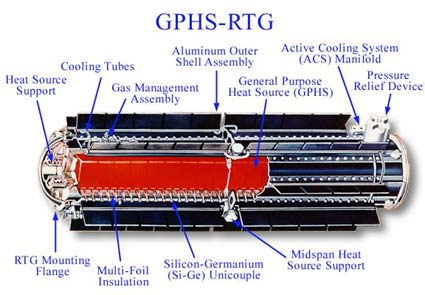[/caption]
As if things weren’t tight enough at NASA, now the US House and Senate have decided to cut the funding to restart production of plutonium-238 (Pu-238), the power source for many of NASA’s robotic spacecraft. Under the Atomic Energy Act of 1954, only the US Department of Energy is allowed to possess, use and produce nuclear materials and facilities, and so NASA must rely on the DOE to produce these power sources and the fuel. A report by the National Research Council says “the day of reckoning has arrived” and that NASA has already been forced to limit deep space missions due to the short supply of Pu-238.
Pu-238 is needed for radioisotope thermoelectric generators (RTGs) that supply power for systems and instruments on spacecraft travel too far from the Sun to rely on solar energy or land on surfaces with long “nights.” For example, the Voyager spacecraft utilize RTGs and are still able to communicate and return science data after over 30 years of operation, and now are at the outer edges of our solar system.

Pu-238 is expensive to produce, but it gives off low-penetration alpha radiation, which is much easier to shield against than the radiation produced by other isotopes.
Pu-238 does not occur in naturally, and the United States has not produced any since the late 1980s. It purchased Pu-238 for NASA missions from Russia during the 1990s, but those supplies reportedly are now exhausted. The NRC based its estimate of NASA’s Pu-238 requirements on a letter NASA sent to DOE on April 29, 2008 detailing space science and lunar exploration missions planned for the next 20 years.
The cost of restarting production appears to be the major reason for the cut, as estimates are it would cost at least $150 million.
The DOE requested $30 million in FY2010 to restart production, but the House cut that to $10 million when it passed the FY2010 Energy and Water appropriations bill (H.R. 3183) on July 17. The Senate went even further (S. 1436), completely cutting funds for restarting production of Pu-238.
Both the House and Senate Appropriations Committees complained that DOE had not explained how it would use the funds.
But if funds aren’t made available soon, NASA may have to revamp its plans significantly for the New Frontiers missions, lunar rovers, and other deep space missions. There are other isotopes that have been used in the past, such as strontium-90, but Pu-238 has been found to work the best. NASA has also solicited ideas for alternative power sources, as well.
Source: Space Policy Online


Bloody tight-ass politicians! That’s less than half the cost of a frigging frigate in the US Navy.
Obviously science is not a priority for Congress.
Considering that AIG gave out over $165 million in bonuses after securing more than $170 billion in federal funds, $150 million doesn’t seem like much.
It’s interesting to note that the federal funds AIG received are equivalent to NASA’s budget for an entire decade.
My first impression was to share the rage, but this
makes me agree with the politicos.
How hard can it be to explain how to restart an old project? It’s not like this is completely unchartered territory.
I obviously think it’d be a great investment – in the people doing the nuclear work too, of course. But I’d like to be sure that the money does indeed benefit the right people rather than get sucked into someone’s pet project.
“Both the House and Senate Appropriations Committees complained that DOE had not explained how it would use the funds.”
When I first read this, I immediately thought to inundate Congress with photo imagery taken by Pioneers 1 & 2 , Voyagers 1 & 2, Galileo, Cassini and New Horizons, to mention a few, of the space missions made possible with good, old RTGs. The ROI here is incredible. To chuck it all over $150 million sounds penny wise but pound foolish.
Why act out being a pro-science politician when you can pay a blogger to convince everyone you are, for a fraction of the cost?
…The question is if voters will hold their leadership accountable for making short sighted choices like this.
Hoku, Your comments are right on the mark. Another shortsighted decision made by Congress. It shouldn’t be entirely surprising, however. I’ll wager that if you polled the members, less than half could name the 9 planets (sorry, still holding out hope).
From where I sit in Sydney Australia, so far as I can tell US congress seems to be almost solely comprised of businessmen, people with religious or so-called ‘moral’ agendas, and ex-servicemen – not a good recipe for funding of science. Unless of course it’s DARPA or DoD related science.
Personally, I think it is amazing that NASA and related projects get any funding at all now that the cold war is over, with people like this at the helm.
@ Astrofiend: Ditto! ( And I am a natural-born US citizen and taxpayer)
Congress will back anything that they think will help them financially.
To them the space program is not a profittable system, so it gets low priority.
They claim to be religious, even putting forth a “moral agenda” but they are hypocrits. Their morals can easily be bought.
So much for “the change we need.”
Hoku, your logic has profoundly bummed me out.
It’s true and it’s tragic. We’ve given the elite few at AIG enough money to secure their financial solvency at the expense of the betterment of all man kind.
Utterly ridiculous. It’s enough to inspire a revolution.